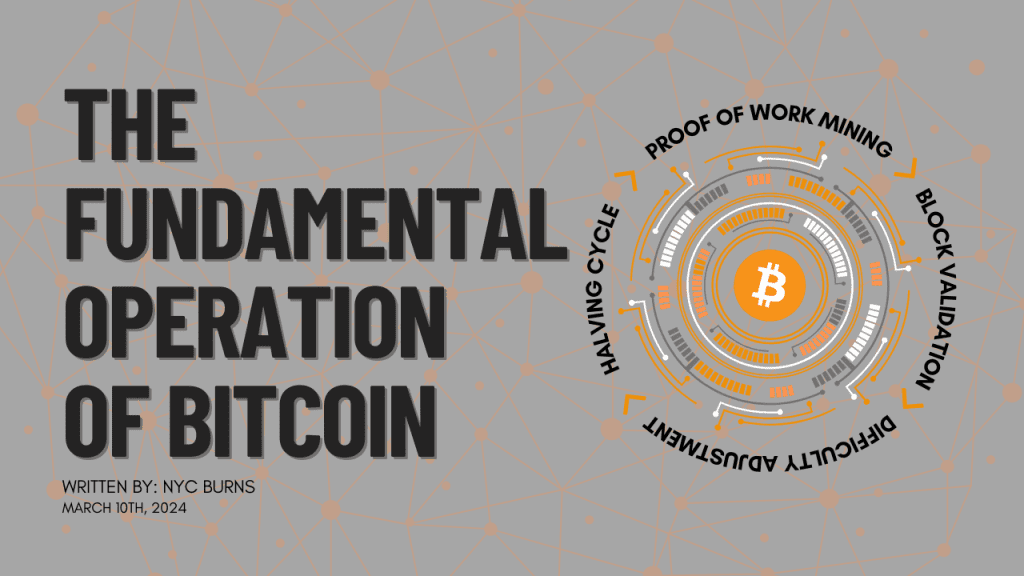Bitcoin is simply a network of computers running an open-source protocol that validates the state of the Bitcoin blockchain. The state of the blockchain represents the amount of bitcoin in each wallet on the network; this is also referred to as the ledger or the state of the ledger. People all over the world are using the Bitcoin network for many different reasons, and these are the primary ways they may do so: transacting or holding bitcoin, validating the state of the ledger, or mining bitcoin. Before increasing altitude and thinking about the investment thesis, or the positive societal impacts, or how it’s unlocking once lost natural resources and human capital, I see it helpful to understand the basic operation of the Bitcoin network.
Bitcoin is a distributed ledger technology where nodes – computers which hold the entire history of the blockchain and validate compliance with the protocol – continually validate the state of the ledger as new transactions are seeking final settlement. In order for transactions to be settled on the network, they must be added to a block of transactions and computationally in cyberspace be welded to the blockchain; the blockchain IS the ledger of ownership. That process of cyberspace computationally welding within the Bitcoin network is commonly known as Proof of Work, PoW, or mining for short. Proof of Work means exactly what it says, miners must prove their honest work by expending computational hash power.
But why would anyone want to utilize this network that continually validates the ownership of the individual units, bitcoin, or fractions of units, satoshis or sats? The value of private property rights, our relationship with money, money’s impact in our making sense of the economic reality around us, and the characteristics a money, must be optimized far beyond the scope of this writing. If you’ve not done your homework on these concepts yet, I highly recommend you read “The Bitcoin Standard,” by Saifedean Ammous; if you have done your reading, you know the conclusion is that people seek to store their economic value in that which has the highest stock-to-flow ratio – now Bitcoin. Moving forward, Bitcoin with a big ‘B’ represents the network as a whole and bitcoin with a little ‘b’ represents the monetary asset one may own.
Bitcoin’s protocol dictates that there will only be 21,000,000 bitcoin to ever exist and it also dictates the issuance schedule of those new bitcoin. Interestingly enough, the network enforces these at the same time it is computationally welding new blocks to the blockchain in cyberspace via PoW. Bitcoin miners are computers specifically designed to run the Bitcoin protocol in an attempt to add blocks to the blockchain. They’re not just doing this for fun though, they’re incentivized with a reward for adding a block to the blockchain; this reward is the block reward or block subsidy. It’s important to know that it’s the miner who finds the correct input first, who receives the block reward.
The Bitcoin protocol dictates that in order to transfer bitcoin on the network a transaction must first be created, it must be added into a block, that block must be mined into the network via PoW, the network of nodes must validate that block is in compliance with the network rules, and if it’s validated by the network of nodes, it’s deemed settled. The Bitcoin miner that mined this block into the network earns newly created bitcoin as a reward, but there’s much more to it. In 2009 when the Bitcoin protocol was set into motion, the miner that added a block to the blockchain received 50 bitcoin per block. You might think the Bitcoin miners would increase their production of blocks to earn more bitcoin by speeding up and innovating their mining computers, but the protocol dictates a difficulty adjustment that regulates the rate at which blocks are added to the blockchain.
The inner process of PoW mining is simply a computer guessing to find the correct input that produces a predetermined output, where that output is determined by the difficulty adjustment. There’s no better way to find that input first than by guessing or hashing as fast as possible. Bitcoin mining computers have progressed rapidly in efficiency in that guessing game; however, to truly increase the miner’s probability of mining the next block and therefore earning the reward, they must scale their operation to many more than just one mining computer. In the process of seeking the block reward there comes increasingly more computational power or hash power. The difficulty adjustment adjusts up or down every 2,016 blocks added to the blockchain based on the total computational power of the globally distributed and decentralized Bitcoin network in order to regulate that one block is added to the blockchain every 10 minutes. So, the more mining computers powered up on the network, the harder it becomes to find that correct input which produces the predetermined output.
With the difficulty adjustment we know blocks will be produced approximately every 10 minutes, we also know that the first miner who finds the correct input earns a block reward for the computationally intense work done, so how is the supply capped if new bitcoin are produced every 10 minutes? The Bitcoin protocol also dictates what’s known as the halving; also referred to as the halving cycle or halving epoch. The halving cycle commands that every 210,000 blocks added to the blockchain, the block reward is reduced by half. When the creator of Bitcoin, Satoshi Nakamoto, set Bitcoin into action, the block reward was 50 bitcoin per block. In 2012 that reward reduced to 25, then again in 2016 to 12.5, and as of writing this we’re in the 6.25 block reward epoch – an epoch is from beginning to end of each 210,000 block interval. This year in 2024, the block reward will reduce by half again to a mere 3.125 bitcoin produced every 10 minutes. Together, the difficulty adjustment and halving cycle regulate the production of new bitcoin and what follows is a capped supply.
Now, there’s a very important detail we’ve not yet covered and that’s block validation. Bitcoin miners procure energy, power and run mining computers, and may find that correct input first in order to add a block to the blockchain; but before they can earn the block reward, the block they propose to add to the blockchain must first be validated as in compliance with the protocol by the entire globally distributed network of nodes. Simply put, nodes have a rule book that each block must be in compliance with, and if it’s not, it’s rejected from the network as invalid. An important thing to note here is that mining bitcoin via PoW requires resource intensive work to be done whereas validation of the blockchain is virtually zero, and remember that there is no central copy of the ledger. Every individual node on the network can validate for themselves the state of the ledger. To run a node yourself requires some hardware that may cost a few hundred dollars in today’s prices, power, an internet connection, and a few hours to learn to operate it.
Most people who’ve not studied how Bitcoin works believe that it could in some way be hacked, and we’d do ourselves a disservice if we didn’t ask, “couldn’t Bitcoin be hacked like other networks we’ve seen in the past?” Stated in the opening sentence, Bitcoin is an open-source protocol anyone can download and run on their computer by which they join the network. They can follow the protocol and they can even make any change to the protocol they run; however, their protocol will no longer be in compliance with the Bitcoin protocol and will therefore be rejected from the network and this will also create a new network with the alternative protocol including those who decide to join. The Bitcoin network is a network of individual computers operating with the same set of protocols and seeking to protect those protocols as those operating nodes have a vested interest in the integrity of the network.
Another way someone may try “hacking” Bitcoin could be an attempted 51% attack. This is where some coordinated effort gains control of 51% or more of the hash rate of the network. The hash rate is the total number of guesses or hashes the miners are doing in a given timeframe while trying to find the correct input. The current hash rate is 588.05 terahashes per second, or 588,053,367,738,149,500,000 hashes per second, or five hundred eighty-eight quintillion, fifty-three quadrillion, three hundred sixty-seven trillion, seven hundred thirty-eight billion, one hundred forty-nine million, five hundred thousand hashes per second. In 2022, the Bitcoin Mining Council,
Bitcoin is a globally available protocol anyone can choose to be a part of, and this network enables them to store economic value in a network that produces less and less of each individual unit maintaining the value of each as compared to the whole; this illustrates Bitcoin’s high stock-to-flow ratio. In the process of maintaining continual updates of ownership via bitcoin mining and node validation, the network regulates bitcoin production and compliance with the network protocol. It does all this with zero trust in some other party. In fact, Bitcoin’s protocol treats every actor on the network as a potential bad actor. This is why every individual node on the network must validate each block being added to the chain as being in compliance, and why the bitcoin miners compete with hash power to computationally weld the next block to the chain in cyberspace. This is an individually incentivized network where the more an individual actor seeks what’s best for himself, the more he strengthens the network and protects his own bitcoin.
In conclusion, the Bitcoin network stands as a globally accessible protocol, offering individuals the opportunity to store economic value within a system characterized by diminishing unit production, exemplifying Bitcoin’s high stock-to-flow ratio. Through the decentralized processes of mining and node validation, the network meticulously regulates bitcoin production and compliance with the protocol. Operated on the principles of individual incentives and zero trust, Bitcoin treats every participant as a potential bad actor, ensuring the integrity of the network. This exploration serves as a foundational understanding of Bitcoin’s operational dynamics, inviting further inquiry into its evolving ecosystem. I hope this writing about the operation of the Bitcoin network is helpful in your journey to understanding Bitcoin.
By no means am I an expert in every detail, but I’ve studied diligently for a few years now and feel confident in the concepts explored here. If I’m missing something, please let me know so that we can all learn something!
This is a guest post by NYC Burns. Opinions expressed are entirely their own and do not necessarily reflect those of Satoshi’s Journal.
Follow me on X (Formerly Twitter) – https://x.com/NycAndGriffShow


1 Comment
Did you enjoy the read?? Come talk with us on X; link is above at the end of the article. 👍